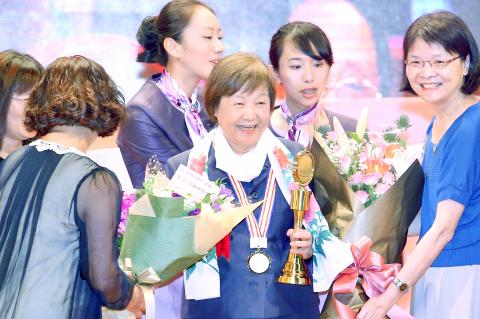Taiwanese should be considered ethnically distinct from Han Chinese, as a majority are more closely related to Aboriginal Austronesians and Pacific islanders, Taiwan’s leading hematologist and medical anthropology researcher said on Saturday.
Marie Lin (林媽利) made the comment at a book launch party for her biography, where colleagues and friends presented her with bouquets and a birthday cake to mark her turning 80 this year.
Decades of research using molecular technology to analyze human DNA and genetic markers had convinced her that most Taiwanese, as descendants of lowland Pingpu Aborigines (平埔族群) and highland Aborigines have mixed blood types, and are quite distinct from the genetic characteristics of the two main ethnic groups in China, the northern and southern Han Chinese.

Photo: CNA
Lin is internationally renowned for her pioneering genetic mapping and ethno-demographic studies of Taiwan’s population, with more than 150 papers to her credit.
“The main Hoklo Taiwanese and Hakka population in this nation have Pingpu and Aboriginal bloodlines in their ancestry from centuries of intermarriage, and the analysis of DNA and genetic markers reflects this new understanding of the close relationship between Taiwanese and Austronesians and Pacific islanders,” she said.
“Through the long history of ethno-cultural evolution on Taiwan, which was isolated from other main population centers, we can consider the result as forming a ‘Taiwanese people group,’ which is distinct from the Han Chinese people,” she said.
Genetic contributions from the Pingpu and Aboriginal bloodlines gave Taiwanese the traits of adventurous ambition, open hospitality to outsiders and a positive, sunny disposition in general, she said.
Lin has served as director of transfusion medicine and molecular anthropology at Mackay Memorial Hospital in Taipei — where she set up the nation’s first blood bank — since 2000, and been a professor at National Taiwan University’s Institute of Forensic Medicine since 2004.

Beijing could eventually see a full amphibious invasion of Taiwan as the only "prudent" way to bring about unification, the US Department of Defense said in a newly released annual report to Congress. The Pentagon's "Annual Report to Congress: Military and Security Developments Involving the People's Republic of China 2025," was in many ways similar to last year’s report but reorganized the analysis of the options China has to take over Taiwan. Generally, according to the report, Chinese leaders view the People's Liberation Army's (PLA) capabilities for a Taiwan campaign as improving, but they remain uncertain about its readiness to successfully seize

HORROR STORIES: One victim recounted not realizing they had been stabbed and seeing people bleeding, while another recalled breaking down in tears after fleeing A man on Friday died after he tried to fight the knife-wielding suspect who went on a stabbing spree near two of Taipei’s busiest metro stations, Taipei Mayor Chiang Wan-an (蔣萬安) said. The 57-year-old man, identified by his family name, Yu (余), encountered the suspect at Exit M7 of Taipei Main Station and immediately tried to stop him, but was fatally wounded and later died, Chiang said, calling the incident “heartbreaking.” Yu’s family would receive at least NT$5 million (US$158,584) in compensation through the Taipei Rapid Transit Corp’s (TRTC) insurance coverage, he said after convening an emergency security response meeting yesterday morning. National

Taiwan is getting a day off on Christmas for the first time in 25 years. The change comes after opposition parties passed a law earlier this year to add or restore five public holidays, including Constitution Day, which falls on today, Dec. 25. The day marks the 1947 adoption of the constitution of the Republic of China, as the government in Taipei is formally known. Back then the Chinese Nationalist Party (KMT) governed China from Nanjing. When the KMT, now an opposition party in Taiwan, passed the legislation on holidays, it said that they would help “commemorate the history of national development.” That

Taiwan has overtaken South Korea this year in per capita income for the first time in 23 years, IMF data showed. Per capita income is a nation’s GDP divided by the total population, used to compare average wealth levels across countries. Taiwan also beat Japan this year on per capita income, after surpassing it for the first time last year, US magazine Newsweek reported yesterday. Across Asia, Taiwan ranked fourth for per capita income at US$37,827 this year due to sustained economic growth, the report said. In the top three spots were Singapore, Macau and Hong Kong, it said. South